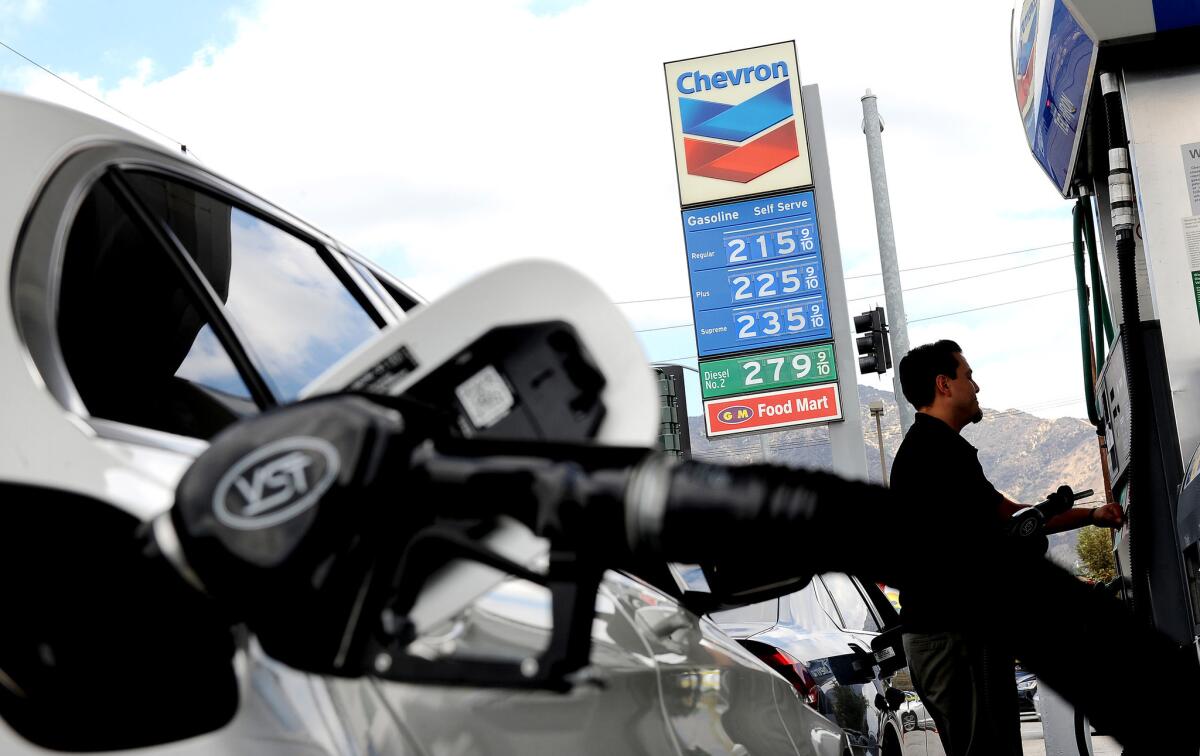Gov. Jerry Brown makes budget the latest battleground on climate change

Motorists fill up at a Chevron station in Burbank in September. Gov. Brown is moving forward with his goal of cutting the state’s petroleum use in half by 2030.
Gov. Jerry Brown is looking to make good on a promise to curb California’s petroleum use by shifting away from new legislation and instead tucking his fuel-reduction goal inside the state budget.
Oil companies spent millions of dollars in 2015 to strip a controversial climate change bill of its provision slashing petroleum use in half by 2030. At the conclusion of that bruising fight, a defiant Brown stood before reporters in the Capitol and declared war.
“Oil has won the skirmish. But they’ve lost the bigger battle,” he said. “Because I am more determined than ever ... we’re not going to miss a beat.”
The budget the governor submitted to the Legislature last month proposed spending a third of the state’s cap-and-trade funds, about $1 billion, on public transit, promoting electric vehicles and other programs, all with the explicit goal of cutting oil use by 50% by 2030. Those dollars were collected through the auction of pollution credits to companies that emit greenhouse gases.
In doing so, the governor’s decision to place such a visible marker could be adding a sizable new wrinkle to budget negotiations this spring in Sacramento.
H.D. Palmer, a spokesman for Brown’s Department of Finance, said the inclusion of the petroleum-reduction goal in the budget proposal reflects the governor’s commitment to “keep that issue on the front burner” in light of what happened with last year’s climate change bill, SB 350.
“If you’re not successful on the first go-round, it doesn’t mean you abandon your principles,” Palmer said. “There are a variety of ways that you can achieve that, and the budget plan continues the efforts to move us toward that goal.”
Brown has maintained a laser-like focus on the oil-reduction target, first unveiling it in his 2015 inaugural speech and frequently mentioning it since. The target shows up in several strategic documents by the state Air Resources Board, which manages the state’s cap-and-trade program and has sweeping authority to regulate air pollution.
“Oil is the heart of modern prosperity, and yet it has the destructive impact that it’s going to undermine that prosperity very quickly. So we have to move off it,” Brown said at a news conference last September, adding that it’s “not a change that’s coming willingly.”
The administration says cutting petroleum use in cars and trucks is a crucial part of its climate change strategy because transportation accounts for an estimated 40% of California’s greenhouse gas emissions. But the concept has been hard to swallow for some business-aligned Democrats in the Legislature, who broke with the party last year to block the oil-reduction clause.
The air board estimates that existing policies already will get California to a 25% reduction in petroleum consumption by 2030. Figures put forth by the auto industry estimate the figure could be even higher.
Going the rest of the way toward Brown’s goal will require continued improvements in vehicle fuel efficiency, decreasing the number of miles Californians travel every year and investing in fuel sources with lower carbon content, the state’s Air Resources Board says.
The governor’s new budget proposal relies heavily on mass transit, proposing to add an extra $400 million of discretionary cap-and-trade funds, a more than sixfold increase. An additional $500 million would go toward consumer rebates for electric vehicles and low-carbon fuels. The proposed boosts in spending are a combination of new cap-and-trade dollars and money left unspent after last year’s stalled negotiations in Sacramento.
Typically, legislators hew to party lines when it comes to voting for the budget. But some more-moderate Democrats could find it difficult to vote for a budget package that includes language similar to last year’s oil provision in SB 350, which some Democrats at the time argued could hurt low-income and commuter-reliant communities.
Assembly Speaker-Elect Anthony Rendon (D-Paramount) says some Democrats framed their opposition of SB 350 as a desire for greater oversight of the powerful Air Resources Board, which would have had discretion over how to implement it.
“If that’s the issue, then maybe the governor and I should be looking at that,” Rendon said. Otherwise, he added, pouring funds into the same goal could make it difficult to reach consensus on the governor’s new plan.
Oil companies spent nearly $12 million on lobbying from July 1 to Sept. 30 last year and blanketed the airwaves as the fight over the petroleum targets was at its height.
(The bill’s other provisions to boost renewable energy goals and double energy efficiency in buildings by 2030 ultimately passed and were signed into law).
Industry leaders are now closely watching the budget negotiations.
The Western States Petroleum Assn., the industry’s largest lobbying organization, said in a statement, “If the governor is going to push these expenditures forward, he will need to demonstrate to the Legislature, and the people of California, how proposed spending can dramatically reduce greenhouse gas emissions.”
The governor has not been shy about his plans to use executive power to further his climate goals, particularly the petroleum-reduction target.
But the fact that it hasn’t been given the force of law means any action Brown takes will remain at risk of being dismantled once he leaves office in 2018.
“I do remain of the strong belief that [defining petroleum targets] statutorily is the best way to do it,” said Senate President Pro Tem Kevin de León (D-Los Angeles).
Kathryn Phillips of Sierra Club California, which supported the oil provision of SB 350, agrees “it’s not the same as a mandate,” but applauded the governor for finding a way around the political stalemate to work toward cutting gasoline use now.
“The administration is pressing forward with what they can do at this point, but everything they’re doing is essentially consistent with that goal,” she said.
For more on California politics, follow me @cmaiduc
ALSO:
More than $1 billion cap-and-trade funds unspent
Full coverage of California’s climate change fight
Brown takes spot on global climate stage: ‘They’re not calling him Gov. Moonbeam anymore’
Political updates from Sacramento
Tea party in California stakes claim to city, county races
More to Read
Get the L.A. Times Politics newsletter
Deeply reported insights into legislation, politics and policy from Sacramento, Washington and beyond. In your inbox three times per week.
You may occasionally receive promotional content from the Los Angeles Times.







